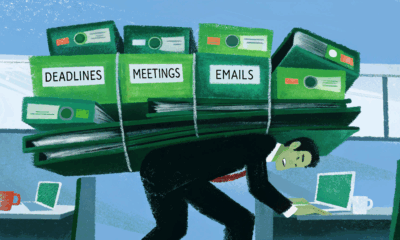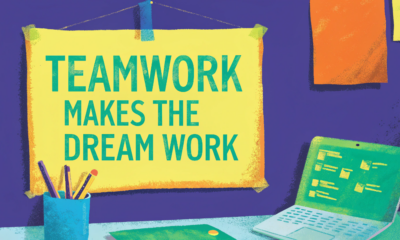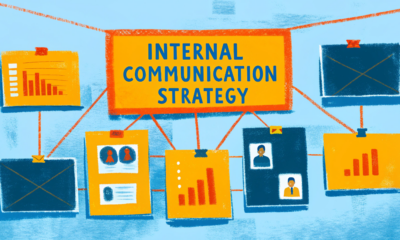Collaboration
4 Common Problems of Virtual Teams are Solved

Low-stress level, no commute, no shoes, PJs only, spending more time with family and friends, and so much more. Sounds neat right? According to some studies, remote work has brought higher productivity and a more positive work-life balance since the beginning of the pandemic. However, it’s not all rainbows and butterflies, is it? We have been facing some challenges, to say the least. We struggle with unplugging ourselves once the work is done for the day, we need our office gossip, and even though we don’t need to wear shoes, we still kinda miss them. Many problems can appear when we are managing virtual teams. However, does that mean we cannot ace a video meeting or have the same level of communication with our teammates as we did before? Never! All we have to do is get our hands to the right collaboration tools to manage our virtual teams. I give to you the solutions to the most common problems we’ve faced working from home. Trust me, it really is as easy as pie!
1. Communication breakdown: it’s not all about messages — it’s about meaning
The one most reported problem of remote teams is communication — or the lack of it. But it has nothing to do with missed messages. It has everything to do with lost context.
When you communicate face-to-face, 70–90% of what you intend is communicated through body language, tone of voice, and facial expressions. Remote workers lack that level. An urgent message meant to be productive will be cold. A wait in responding will be perceived as not caring.
That’s why business communications tools like Chanty, Google Chat, and GoToMeeting aren’t nice-to-haves, they’re must-haves. They facilitate teams to communicate in real-time, clarify their communication, and utilize richer media like voice and video. Still, the best tool is nothing without a shared communication culture.
HR comes into play here. Get teams to figure out how they communicate: messaging vs. meeting, how they handle urgency, and what “offline” means. Prioritize making voice notes and camera-on calls the new normal to bring back that human feel.
Communication isn’t only about words. It’s about being heard — and feeling connected.
2. Collaboration without clarity: the hidden cost of scattered work
In an office, things naturally tend to overlap. You stretch over a desk. You cut off someone at the coffee machine. You interpret a face at a brainstorming session.
In virtual teams, it doesn’t happen. And without the proper tools, folks will naturally feel like they’re working in solitude — despite being part of a team.
This is where Google Workspace, Microsoft 365, Dropbox, and OneDrive come in. These apps are not simply storage devices — they create a virtual workspace where collaborators can work together. Teams can work together on docs, comment in real-time, and have one source of truth.
But what really matters is psychological safety. If employees don’t feel free to give each other working drafts or ask for help, technology can’t fix that. HR leaders must create a space where collaboration means learning alongside one another, not just working alongside one another.
Technology reduces the friction. But humans reduce the fear. That’s how collaboration thrives.
3. Remote project confusion: why visibility matters more than ever
Without structure, remote projects can drift. Deadlines are missed. Jobs get blurry. Team members do not know what others are doing — or what they must do.
Project management tools like Asana, Jira, Basecamp, and SmartTask bring much-needed discipline. They break goals into doable pieces. They delegate tasks. They provide timelines and certainty.
But aside from task management, these sites are emotional clarity tools. When everyone can see who’s working on what, stress goes down. Nobody feels like they’re doing it all themselves. Nobody feels ignored. Transparency is peace of mind.
For HR, it’s a golden opportunity. Utilize these tools not just for productivity — but for inclusion. A reserved junior team member during meetings can spring to life when they are given clear guidance in a task board. A mute struggler might reveal to us their stress in overdue assignments.
Project management tools have secrets. Savvy HR teams listen intently.
4. Time and productivity tracking: from surveillance to self-awareness
Time tracking is one of the more controversial aspects of remote work. Done badly, it’s intrusive. Done well, it’s an amazing wellness and performance tool.
TimeDoctor, Hivedesk, Toggl, and PomoDone are some of the applications that enable teams to see how they spend their time. They show data on attention, idleness, and task-switching. To remote teams, this isn’t accountability — it’s awareness.
Most remote workers struggle to “switch off.” They work longer, take shorter breaks, and quietly burn out. HR can use time-tracking data not as a punisher, but as a protector. Recognizing overwork early is an act of care.
Furthermore, these tools empower people. People can look at when they’re most productive, or where they drift off course. They can set their own schedules, and build better habits.
The true value isn’t in tracking time — it’s in getting time to work more effectively for individuals.
Final Thought
No matter how many tools you bring on board, virtual teams will fail if their human needs are not met. The need to connect. To be seen. To understand. To trust.
Which makes HR’s role so critical. You’re not just choosing software —you’re developing culture. When you combine great tools with compassionate leadership, you don’t just solve issues — you create an environment where remote doesn’t equal removed.
Because in the end, remote teams don’t succeed because of technology.
They succeed because they care.
Collaboration
The Power of Collaboration: Exploring the Dynamics of Group Coaching

The working world is changing. And employees know that. But what’s changing goes beyond the ever-growing debate of whether employees should physically return to their workplace.
With the growth of Artificial Intelligence (AI) tools, workplaces are adapting to accommodate the need for new skills, demonstrating the necessity for professional development and coaching in the workplace.
While some may believe AI removes positions, it’s doing the opposite. It’s created jobs and skill sets that haven’t existed before, forming a new landscape for the digital world. The problem isn’t that AI is taking jobs, but that workers are not yet ready for the roles that AI has created.
According to the University of Phoenix’s Annual Career Optimism Index of 2022, 40% of those surveyed said they “worry their job skills will become outdated because of advancements in technology such as automation, artificial intelligence, and robots.” These workers know that the time for upskilling is now. More than half of those surveyed said they must learn new skills within the next year to continue their careers.
And they want to work with employers that recognize that need and offer opportunities to challenge themselves and help them step into the newly-created roles. 68% of those surveyed said they would stay with their employer throughout their career if the employer provided opportunities to upskill.
Professional development is essential for retention, but it’s costly and intimidating for workers.
What is group coaching, and why does it work? Let’s get into how this form of coaching can help your staff upskill.
What is group coaching?
Unsplash.com
Group coaching is a type of professional development where a coach works with a small group to help them learn new skills and reach their goals. During one-on-one coaching, only one employee works with the coach and receives their attention. With group coaching, all members have a common goal. The coach may set aside time to work with each member individually, but they generally meet and work as a group.
What does group coaching look like?
Group coaching can look different depending on the environment. For example, outside the workplace, you may see group coaching as an online course where one coach works through presentations and provides activities to their subscribers.
Group coaching may be more nebulous, with a larger group of people working through the content on a website and coming together to chat about the work, with the content’s creator chiming in to assist.
But in the workplace, group coaching typically involves one expert guiding a group of coworkers through lessons. If you work in an office setting, you might set aside a standard meeting time when the coach and group members can meet in person. Or, if you’re remote, you might set up a video call for presentations and use team collaboration tools to work on activities together.
Ultimately, the main aspect of a group coach that’s always necessary is that everyone in the group is working toward a common goal. That goal helps guide the creation and focus of the coach’s presentations and activities.
Group coaching may be for one team at a time. For example, you might have your company’s teams work in a separate group coaching session. But because group coaching centers around a common goal, you may find that cross-team group coaching is just as beneficial, if not more.
You can survey your employees about what skill sets they want to work on and create groups for coaching based on their answers. This step can help you harness more diverse skill sets on each team and encourage cross-team collaboration.
What are the benefits of group coaching?
1. Prevents silos
Your company is looking to adopt a new AI tool. You have assigned one person as the expert on the application. They know all the ins and outs of how to use it.
But that one expert is the only person who knows how to use it. As a result, the rest of your employees continue to work on more time-consuming processes without realizing how the AI tool could benefit them.
Without realizing it, you’ve created a knowledge silo. Unfortunately, silos are a common part of many workplaces. In addition to knowledge silos, you may also have data silos. One team may store their essential data using one application, while another group may keep theirs somewhere else. All the while, they may not realize that they could benefit from each other’s information. The lack of oversight over each other’s data may also diminish the information’s quality. If these teams aren’t working together, your company may not be using the data optimally.
Group coaching can help stop silos in their tracks. By putting together a group of people who want to reach common goals, you can help them develop essential skills that benefit the whole company.
If you pulled together a group to learn how to use the new AI tool, you would no longer have the issue of just one person who could utilize it. Ultimately, you would save time and resources by allowing more company members to access a tool that would make processes more manageable.
Organizing your group coaching around a common goal rather than simply creating groups according to teams can also facilitate more learning throughout your company. For example, if someone from your marketing, customer success, sales, and software design teams wanted to learn how to use the AI tool, they could bring those learnings back to their groups, spreading the knowledge and further helping the company.
2. Allows collaboration and learning from each other
An expert is an essential part of group coaching. But the group doesn’t just benefit from one person. They also learn from each other.
The coach isn’t just a coach. They are also facilitators. They may teach the group as experts, but they also should facilitate discussions among the group and create activities to promote collaboration.
Say you organized a group coaching session for your newest sales representative. You should develop activities such as researching prospects and developing lead-generation strategies together. In addition, you might have them practice sales calls with each other.
While the coach may be able to offer guidance, the reality is that every person in the group also has something to offer. Each comes with their own experience and background, which they can use to assist each other.
Perhaps one sales representative learned a great tip about engaging a potential customer from their previous company’s sales team lead. They can bring that strategy into the discussion, which their fellow sales representatives can use during their sales calls.
Beyond their experience, working as a team can also help each other see different points of view and learn different problem-solving techniques. For example, if someone struggles to understand a concept, another group member may hold the key to offering an explanation they can comprehend.
3. Develops camaraderie
Beyond collaboration, group coaching also helps coworkers develop trust in each other. By working towards a common goal, the group members can learn who their coworkers are. Ultimately, the time spent together helps them see each other in a new light.
This new camaraderie is an especially valuable part of cross-team group coaching. Generally, a sales team member is likely to spend more time with someone on their team than someone on another team. As a result, most meetings they attend will be with their group; they likely sit around people who also do sales; and they generally know their team dynamics better than their other coworkers.
While doing cross-team group coaching is one way to help prevent silos, it’s also beneficial for developing camaraderie across your company. Trust and fellowship create a healthier, happier, and ideal work environment where people feel listened to and supported, even beyond their team’s boundaries.
4. Diminishes intimidation
No one knows all the answers. But a part of coaching is questioning your employee and asking them to think about solutions. In addition, you want them to develop their problem-solving skills, which means that you can’t just provide them with answers all the time.
But being questioned one-on-one can be intimidating and the opposite of what you want from professional development. You want your employee to come out of professional development feeling more confident and ready to tackle new challenges. But not knowing the answers during one-on-one questioning may make them feel less self-assured.
Group coaching prevents all the attention from falling on one person. During individual coaching, the one person receiving the coaching may get their coach’s undivided attention, but that’s not always a good thing. In a group setting, each member won’t feel they need to know all the answers. They can offer solutions, but they can also spend time listening to coworkers’ responses.
Listening is also part of what makes group coaching so beneficial. By hearing their coworkers’ thought processes, they can develop their listening and retention skills, while also honing the skills they initially came to group coaching to form. And because they’ll feel less intimated, they can focus more on the task rather than being stuck in their heads.
5. Fosters a culture focused on learning
By investing in group coaching, you’re showing your employees that you care about their growth. In a time when people are greatly concerned about upskilling, you want to create a workplace where your employees know that they will continue to advance their skills and, therefore, their careers.
By fostering a culture of learning, you’re demonstrating to your employees that you value them and want to help them face the challenges that may arise as the working world adapts to new tools and technologies. In addition, as the modern working world changes, legacy positions may become obsolete.
But new roles will replace them. Upskilling is one part of the puzzle, but so is reskilling, as your employees may need to develop entirely new skill sets for these roles. Rather than hiring new workers, you can invest in your current employees’ future through professional development, like group coaching.
Your employees want to learn, so it’s up to you to provide them with opportunities. Group coaching helps you develop a company filled with employees honing their skill sets, both professionally and interpersonally. These group members learn from their coach, but they also learn from each other. When you make learning a part of your company values through group coaching, you’re setting your company and each worker up for success.
Are you ready to pump up your group coaching?
Employees are looking to upskill right now. And they’re willing to look for companies that offer the opportunity to develop new skills if their current employer doesn’t.
If you want to retain quality workers, you have to retrain them. With the digital landscape changing constantly, the modern workforce requires new skills.
Investing in professional development is vital to keeping your employees feeling supported, but group coaching goes beyond professional development. With group coaching, you can train more people at once and allow them to learn from an expert in the skill set they want to develop.
Some of the key benefits of group coaching include:
- Preventing silos by sharing knowledge and tools across departments
- Encouraging collaboration through shared experiences
- Strengthening communication, including listening, feedback, and problem-solving skills
- Building camaraderie by connecting people across teams and roles
- Reducing pressure, as group settings often feel less intimidating than one-on-one coaching
- Creating a culture of learning that signals your investment in employee growth
- Promoting skill transfer as new knowledge spreads organically within teams
- Boosting engagement and retention by helping people grow where they work
Beyond skills, group coaching fosters interpersonal connections and breaks down barriers between departments, helping to build a more cohesive and confident workforce.
Through working with new people, you can also help cut down on the development of silos throughout your company. And by using group coaching instead of one-on-one coaching, you can also keep the intimidation levels down, making your employees better, more confident learners.
Learning is precisely what you want to keep at the forefront of your company’s culture. Your employees want to learn. And they want to know that you care about developing their skills and knowledge. A learning culture benefits every aspect of your company and makes your business more likely to be ready to embrace whatever the future holds. As long as you offer opportunities to keep learning and growing through professional development, like group coaching, you’ll be able to prepare your employees for every challenge that comes their way.
Collaboration
18 Experts Share Tips for Businesses Switching to Remote Work

The world is going through a lot right now, with the current outbreak of the coronavirus. Lots of things changed in recent weeks, and most prominently, a lot of companies switched to working remotely. While remote work is far from a novelty, many companies are now giving it a go for the first time just now.
To help out everyone who is dipping their toes in remote working, we’ve gathered a few remote work experts to provide their insights and answer one question:
What is your best piece of advice for companies who are just starting with remote work?
Here are their thoughts.
18 Experts share tips for businesses switching to remote work
DMYTRO OKUNYEV — Founder of Chanty
” It’s essential that you promote a healthy lifestyle, as difficult as that may be. You should be setting time to exercise for all your team members to keep them in shape. There are plenty of benefits to exercising, including improving your overall health.
If you want your team to feel good and perform well, you need them to be healthy and rested so that they can work effectively.
I like to lead by example, so I work out every morning. “
ADAM HEMPENSTALL — CEO and Owner, Better Proposals
” Focus on goals rather than time spent working. The great thing about remote work is that you don’t need to work 8 hours per day.
Instead, give each of your employees a goal and make sure they stick to their outcome. As long as the goal is completed, their work is done for the day. “
MAKSYM BABYCH — CEO at SpdLoad
” The more structured and transparent your processes are, the more rapid your growth is.
It is a huge business advantage to have processes that help your team members hit their goals without undue control. “
MELANIE AMINI — Marketing Director at ScholarshipOwl
” Other than the internet and tech support, it is the most important to have firm, written boundaries for working hours.
Before the WFH life begins, you must set the number of hours they must be online and rules/best practices to follow, but you must also trust your employees.”
KEVIN INDIG — VP SEO & Content at G2.com and Founder of kevin-indig.com
” Do a virtual standup. My teams and I share our top 3 tasks for the day to create alignment and connect. It doesn’t have to be a video call and it doesn’t have to be that long. Just a quick update.
The cool part is that this helps you to focus on what success looks like. It’s not just for others but also yourself. “
KENNY TRINH — CEO of Netbooknews
” Nothing is more important to remote team communication than the team’s digital inbox. Without the ability to have organic, in-person interactions, employees can easily fall victim to “out of sight, out of mind.”
Thus, it’s critical to create a tech stack that provides multiple avenues for communication. “
SHAWN BREYER — Owner of Atlanta House Buyers
” Each week, a full team meeting should be held to review the KPIs of each member.
It makes them feel like they are accountable and they see how other team members should be performing. If there are people who aren’t getting results, the team needs to discuss if it is goal, team or resources related.
When that person or the team finds if the trend is that no one ever meets their goals, the leadership needs to determine if people are lacking training and resources or if they are not a good fit for the team.“
DARREN VIRASSAMMY — Co-Founder and COO, 34 Strong
” Make sure to have your 1-1s with each team member. Use this disruption as a chance to pause, evaluate what really matters, and grow as a manager. Each shift has to get the team focused on what’s still strong.
There’s an opportunity to realign the team’s work with core values. It’s a chance to strengthen the rhythm for completing work and keeping team members engaged during these unprecedented times. “
CATHY DECKER — Co-founder and Principal Decker/Royal
” Don’t micro-manage, don’t call unexpectedly to time how long it takes to answer the phone, and don’t plan unnecessary meetings. Hold your team members accountable to their deliverables, and then allow them to do their jobs. “
ANH TRINH — Managing Editor, GeekWithLaptop
” Ask an experienced co-worker to show the ropes to the rest of the team. Having someone who knows the ins and outs of the remote work environment can quickly instruct members on how to work properly and productively within a week or so is a great way to get started. “
BRET BONNET — Co-Founder/President, Quality Logo Products
” Be ready to work twice as hard. Make as many team projects as possible, even if they don’t have to be. The more opportunities to work together, the less likely team members are to feel disconnected and the more productive they’ll be! “
MONICA EATON-CARDONE — Co-Founder and COO, Chargebacks911
” Make sure that any individual working from home feels supported. It’s important to remember that even though your employees are not physically in the office, the communication line ought to remain open. “
KATARZYNA IWANICH — Co-Founder, Insightland
” Keep a written agenda such as online schedule with a list of online meetings and tasks for specific days. It helps to plan your job and be efficient in time management.
At the same time, if the team gets stuck with some part of the process, working with deadlines gets easier. “
MARK WEBSTER — Co-Founder, Authority Hacker
” The first thing to do is to get everyone aligned to a strict “communication time.” The thing is, distractions are normal at home.
It’s important to synchronize and have a non-stop 8–10 AM slot every day (or week, whatever suits your team) for the team to be online, available and present for anything that occurs on a day to day basis. “
BEN TAYLOR — Founder, Home Working Club
” My main piece of advice is to trust your team and don’t introduce rules for the sake of it. If you’ve recruited and managed people well, trust shouldn’t be an issue.
Some excuses are generated reasons for things like enforcing instant logins or using screen monitoring software. DON’T DO THESE THINGS.”
ANGELA PEACOCK — CEO, PDT Global
” Recognize that the fears of your employees may not be the same as yours. While you are worried about productivity and how to keep your business alive through this strange time, some of your staff might be worried their children won’t get into school shot during the next year. Others among them may also be anxious about whether the technology is going to let them down and they won’t be able to work. “
JARRED KESSLER — CEO and Founder, EasyKnock
” Use the time to exercise your brain and your health. It’s a huge stress reliever and keeps your immune system boosted.
Go outside if you live alone and pick up the phone if you live with others. If you interact with a loved one once a week at a minimum, you keep your brain more alive than ever. Ask them how they are doing live.”
TAPAN PATEL — Co-founder, Third Rock Techno
” For a smooth transition to a culture of remote working, facilitate time communication. Ensure that your team is equipped with a proper computer and high-speed internet at home.
Help them get all the resources they need to collaborate with each other efficiently. Clearly explain to the team the processes that you plan to follow while everyone is working remotely. “
Conclusion
If you and your company are new to remote work, don’t get scared away by the few challenges it has. Instead, focus on the many positives and you will see that you and your company can be just as productive when working remotely, if not even more. If you have any tips besides the one shared above, please share them with us in the comments to this post.
Collaboration
10 Pros and Cons of Working Remotely

Work-from-home arrangements are most successful when employers set clear parameters and invest in technology, such as videoconferencing, to help remote personnel feel like they are part of the team, – McDonald
Remote working, working-at-home, telecommuting, and any other similar variations of terms that describe working outside the walls of a traditional office, are getting increased popularity in recent years. Before Covid 19 working from home was a luxury that many of us dreamed of. Seeing pictures of remote workers in some distant places was something that we all wished for (at least I know I did). But let’s be real. Not all that glitters is gold. Working from home has some pitfalls as well.
There are many studies and statistics that favor both ways but together with my team, we decided to make a pros and cons list that will take you in and help you investigate this way of working, letting you weigh the advantages and disadvantages of the same.
The psychological and practical benefits of remote work
Let’s be honest — commuting five days a week to gaze at fluorescent lights while battling back-office gossip and surprise meetings isn’t necessarily a productivity dream. Remote work isn’t a trend — it’s a work life upgrade. And no, not because you can go to meetings in your pajamas (although we wouldn’t judge either).
This is what really makes remote work a game changer — for employees and HR teams.
1. You might actually get more done
Working remotely usually means fewer distractions. No watercooler conversation, no spontaneous 45-minute “quick syncs,” and none whatsoever heating fish in the break room.
- How it works: When you’re in charge of your surroundings, you focus more. It’s not anecdotal— psychologists call this lower cognitive load. Your brain isn’t spending energy repressing distractions.
- HR tip: Time to move beyond “Are they online?” to “Did the work get done well?” Focus on results. Trust trumps micromanagement.
2. Autonomy = Motivation
When people have control over how, when, and where they get their work done, magic happens. Self-Determination Theory (Deci & Ryan) is a reminder that autonomy is a strong psychological driver of motivation and engagement. In plain English? People want to be trusted adults.
- In the wild: Remote workers are more likely to feel happy to be responsible — not less. When employees take ownership, they’re apt to deliver.
- HR tip: Grant autonomy, but don’t lose sight of the map. Flexible policies work best alongside clearly set goals and accountability. Freedom thrives with structure — not chaos.
3. Work-life fit wins over work-life “balance”
“Balance” is such a misnomer, as if the work and life are two even weights on the scale. Come on — it’s more like thrashing about with fiery torches. Remote work allows us to glide between roles so seamlessly: parent, partner, pro.
- Psychological perk: It enhances cognitive flexibility and reduces role conflict. In other words: fewer meltdowns between meetings and school runs.
- HR tip: Foster healthy boundaries. Asynchronous options and thoughtful communication windows prevent burnout while keeping the momentum going.
4. No commute = time (and sanity) regained
Let’s do the math. If your one-way commute was 45 minutes, that’s 90 minutes a day—7.5 hours a week. That’s nearly a whole workday stuck in traffic or wedged between strangers on public transit.
- In practice: People use that time to sleep more, eat well, exercise, or spend time with loved ones. All of which results in better work performance.
- HR tip: Sponsor wellness initiatives that capitalize on this gained time. Maybe offer fitness app stipends or reward morning mindfulness routines.
5. A Personalized workspace reduces daily stress
Office thermostats are the holiest workplace battleground. In your own home, you can finally tailor your seat height, control the volume, and sport fuzzy socks without worry.
- Science claims: Reducing “micro-stressors” (like ambient noise or inadequate lighting) supports emotional control and cognitive concentration.
- HR tip: Don’t simply send a laptop. Offer ergonomic advice, remote office stipends, or even workspace setup courses. Help people craft a space where they can actually thrive.
6. Alignment with natural productivity rhythms
Some of us are most productive at 6 a.m. Others discover their creative rhythm after dinner. Chronobiology confirms: people have different natural rhythms. And no, early risers aren’t “better workers” — they’re just wired differently.
- Real-world win: Writers, coders, and designers often say their best work happens outside the 9–5. Letting people match tasks with energy leads to more “flow” and better output.
- HR tip: Embrace results over rigid hours. Define collaboration windows, but let people control when they dive into deep work. You’ll be surprised at the quality that comes out of a 10 p.m. burst of genius.
7. Improved retention and organizational commitment
If people feel they’re trusted, respected, and able to manage their own lives, they’ll stay around. Happiness isn’t an amenity — it’s a retention device.
- Brain boost: Happy workers are healthier, more engaged, and more productive. It’s basic psychology — having control reduces stress.
- HR tip: Offering remote opportunities and flexible work schedules makes your company’s employer reputation shine. It’s no longer an incentive — it’s the standard.
The quiet challenges of working remote: What we don’t talk about enough
Remote work can be empowering — but it’s not always easy. While convenience and adaptability are the touted benefits, many remote workers struggle with issues that quietly undermine focus, engagement, and productivity. Some are personal. Some are structural. Either way, they’re real — and HR leaders need to see them if they want to make remote work truly work.
Here’s a closer, more honest look at why remote work is difficult—and how it isn’t.
1. Lack of structure can derail your day
Without the outside rhythm of office life, it’s easy to get in late, take too many breaks, or succumb to multitasking wicked habits. That much freedom is disorienting. Projects are delayed. Focus drifts. The line between “working” and just sitting in front of a screen becomes muddled quickly.
- Why it happens: Our brains need context and environmental cues to stay task mode. Working in bed or jumping straight from breakfast to meetings can lead to decision fatigue and confusion.
- What helps: Morning routines, blocks of time, and shutdown ceremonies. HR can step in with digital calendars, self-management training, or apps that allow employees to schedule their days with purpose — not anxiety.
2. Loneliness isn’t just emotional — it’s cognitive
Yes, home working makes room. But excessive isolation depletes its benefits. Studies reveal that loneliness engages the same brain mechanisms as physical pain. Over time, loneliness anaesthetises the mind, causes reduced motivation, and increases stress.
Even introverts report they feel a kind of “post-slow disconnection” from their company culture and team. And when lines between home and work begin to blur, it’s easy to just continue working past dinner time — not because you’re being productive, but because there is no off-switch. And so the line blurs even further.
- What helps: Authentic connection — not forced “fun.” HR can create room for real moments: peer sharing, learning circles between peers, or relaxed check-ins human and not required. Encourage hard stop times and authentic lunch breaks, too.
3. Visibility is a real problem
When no one sees your work, it’s natural to question whether it makes a difference. For remote workers, that “out of sight, out of mind” effect is more than intuition. It’s an obstacle to visibility, project work, or career advancement.
- Mind over matter: Motivation theories like Drive by Daniel Pink posit that advancement and acknowledgment are key to motivation. When feedback disappears, so does motivation.
- What helps: Maintain an achievement log. Send regular (but short) reports. Managers have to be trained by the HR function to hold people accountable for results, not effort. Peer feedback and formal performance reviews help contain bias.
4. Not all home offices are equal
One employee might have a bright office and noise-cancelling headphones. Another could be clacking away in a shared living room or splitting time caregiving in the background. Remote work isn’t one-size-fits-all — and when the setup isn’t optimized, performance and well-being suffer.
For some employees, particularly those with caregiving responsibilities, disabilities, or tiny spaces, remote work creates friction, not freedom.
- What helps: HR must touch base on working conditions often, not just on productivity. Offer coworking allowances, ergonomic gear, or hybrid flexibility to those in need of a new set-up. This isn’t logistics — it’s inclusion.
5. Communication gets hefty — and sometimes off the target
Remote teams rely on text, video, and scheduled syncs. That’s work. Tone is lost. Slack is overwhelming. Zoom is exhausting. Without low-stakes moments — like those spent in the hallway or lunchroom — collaboration becomes less adaptive and more transactional.
- Why it matters: Improvisational communication drives creativity. Without it, groups tend to work in silos, and problem-solving happens slower.
- What helps: Implement async-first workflows. Use tools like Loom, Notion, or update recordings to cut down on live meetings. Reward for clarity over speed. HR can shape these by modeling them in leadership teams and documentation practices.
Remote work: ideal in theory, challenging in reality
So home working is the perfect idea — no daily commute, flexible working hours, your own coffee. But this until you experience the reality, and remote work has very real challenges: distractions, loneliness, blurred boundaries, and the sense of invisibility.
Without routine, days become chaotic. Without informal conversation, collaboration breaks down. And not everybody has a quiet, comfortable home office. For many, working remotely can blur the line between independence and burnout.
But here’s the good news: these aren’t personal deficits — these are fixable design problems. With the right support, remote work can work.
HR teams have a responsibility to perform. It’s not just a question of offering remote choices —it’s about creating the appropriate arrangement. That means:
- Prioritizing outcomes, not time spent on the web
- Enabling breaks and clear-cut closing times
- Providing instruments, touch-bases, and adaptable customs
- Empowering managers to practice trust, not command
Remote work isn’t going away. But if we’re ever going to make it a success in the long run, we must get better at how we facilitate it.
-

 Collaboration5 months ago
Collaboration5 months ago18 Experts Share Tips for Businesses Switching to Remote Work
-

 Communication7 months ago
Communication7 months ago6 Communication Plan Templates With Examples
-

 Collaboration6 months ago
Collaboration6 months ago30 Work From Home Memes: Funny Work Memes to Make You Laugh
-

 Collaboration7 months ago
Collaboration7 months ago6 Tips for Lifting the Burden of Too Many Responsibilities
-

 Productivity6 months ago
Productivity6 months agoSuper True Mental Health Memes You’ll Probably Relate To
-

 Collaboration8 months ago
Collaboration8 months ago35+ Collaboration Quotes to Celebrate Teamwork
-

 Collaboration8 months ago
Collaboration8 months ago7 Easy Strategies for Effective Team Communication
-

 Collaboration8 months ago
Collaboration8 months agoThe Definitive Guide to Creating an Internal Communication Strategy





